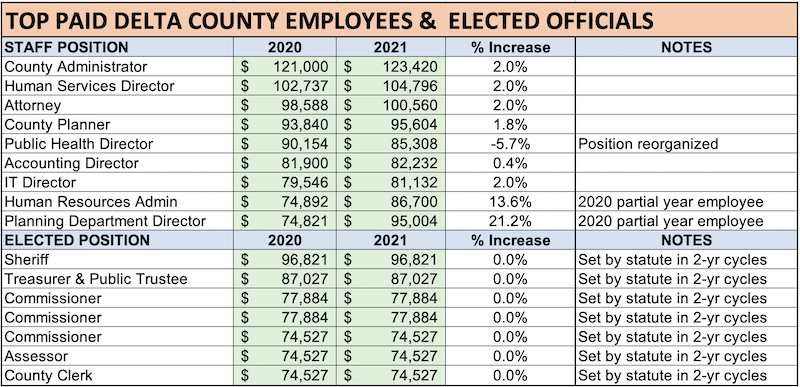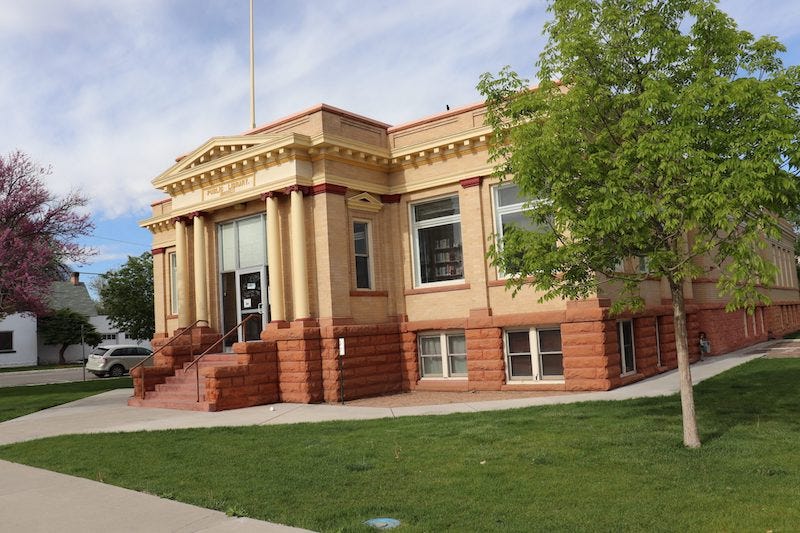
Delta County government enjoys substantial taxpayer revenue from three major sources: Commercial and residential property tax collection, and regular sales tax collection. Since 2017, these combined sources of income have increased 28% growing from a total of $16.8 million to $21.6 million in 2020.
Regular sales tax collection has seen the biggest jump, increasing by 39% between 2017 and 2020 — a dramatic 20% change occurred from 2019 to 2020. While voters approved even higher tax collection in a 2020 ballot initiative, dubbed Back the Badge, this revenue is booked to 2021 and, it’s important to note, that that fund has already collected almost $2 million in revenue and is not included in this graph.
Residential property tax collection grew 28% during the same 2017-2020 period with its biggest jump occurring in 2019. For more information on all assessment data, visit the Delta County Assessor’s summary data web page.
Top paid staff running County government, overpaid planner retires

When the annual budget is developed, anticipated staff raises are among the biggest issues hashed out by county administration and department heads. As a rule, County Administrator Robbie LeValley has set standard raises at two percent, and sometimes three percent in high income years for the county. County Commissioners, however, approve raises for LeValley herself and she has seen an overall salary increase of 35% since her first full year of employment in 2013 — 5% per year on average.
Because Commissioners come and go through the election cycle, LeValley’s salary increases have fluctuated dramatically with her biggest increase coming in the last few years. In 2020, a flush year for the county, she was given a 9% raise while most other staff received 3%. Conversely, LeValley’s 2021 raise was only 2% as was most other county staff.
In early 2021, the county hired Carl Holm as its new Planning Director who came in at a salary of $95,000. Holm “inherited” Kelly Yeager as his planner whose high salary has been questioned by DCCR and other local residents. Yeager was hired by LeValley as a contract planner at a rate of $100,000 per year — $40,000 higher then salary surveys for this position recommend. Later, Yeager was put on staff — at close to this same wage — because he had been performing staff-like activities, which violated Colorado’s contractor rules. Yeager officially retired early this month.
COMMISSIONERS PURCHASE BUILDING BUT QUESTIONS REMAIN

Spearheaded by Commissioner Don Suppes, Commissioners formalized the purchase closing of the old City Market building in downtown Delta on Tuesday. While details are sketchy, the county intends to remodel the building to accommodate a new library replacing the one currently housed in an historic Carnegie building. They, then, will negotiate a trade with the City of Delta to obtain the Carnegie building and remodel it as office space for the County Sheriff’s Department.
Open questions remain:
1) How much of the 26,000 square foot City Market building will the library use? Library board members are asking for a minimum of 15,000 square feet.
2) How will the remaining square footage be used? Earlier proposals included City Police Department offices but library officials are strongly opposed.
3) What will the Intergovernmental Agreement between City and County outlining ownership, upkeep and other expenses look like? IGA’s are typically completed well before action is taken. DCCR assumes negotiations have already taken place since the county has already made the purchase, but City officials have made no formal statement of agreement.
4) How much will the renovations cost the county to turn the new location into a library and much will the renovations cost the county to turn the Carnegie building into a Sheriff’s office? A decade-old study for a planned “law-enforcement complex” estimated costs of $50 million. The details and extent of this plan are unknown, but this price tag is currently being used as a comparative cost versus the current plan.
5) How much will the increased jail space cost at the current facility once office move to the Carnegie building?

